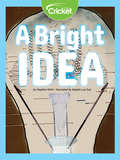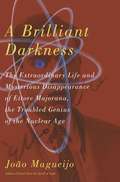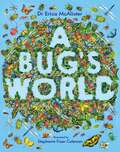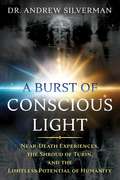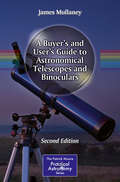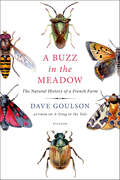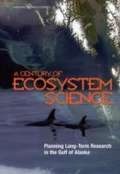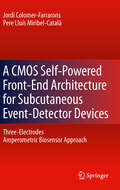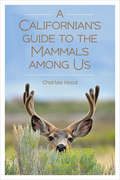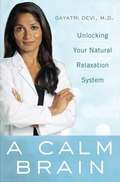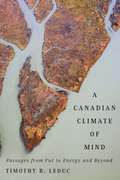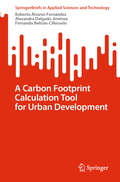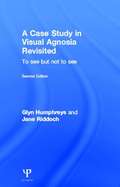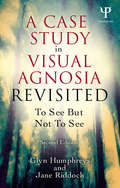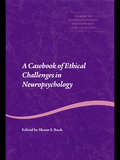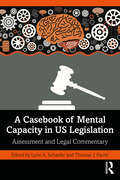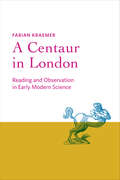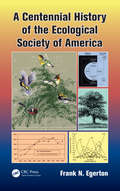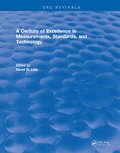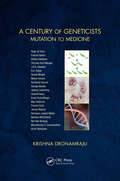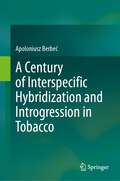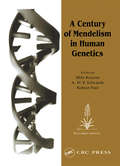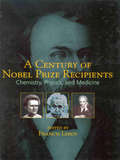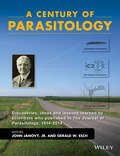- Table View
- List View
A Bright Idea
by Stephen WhittWhat does a light bulb require to burn bright? What happens when a light bulb burns out? Discover how filament, made of one of the heaviest metals, a mixture of two gases, a 60-watt light bulb, and electric currents make this bright idea more than just a bright light! The amazing science behind the light bulb awaits you!
A Brilliant Darkness: The Extraordinary Life and Mysterious Disappearance of Ettore Majorana, the Troubled Genius of the N
by João MagueijoOn the night of March 26, 1938, nuclear physicist Ettore Majorana boarded a ship, cash and passport in hand. He was never seen again. <P><P> In A Brilliant Darkness, theoretical physicist João Magueijo tells the story of Majorana and his research group, "the Via Panisperna Boys," who discovered atomic fission in 1934. As Majorana, the most brilliant of the group, began to realize the implications of what they had found, he became increasingly unstable. Did he commit suicide that night in Palermo? Was he kidnapped? Did he stage his own death? A Brilliant Darkness chronicles Majorana's invaluable contributions to science--including his major discovery, the Majorana neutrino--while revealing the truth behind his fascinating and tragic life.
A Bug's World
by Erica McAlisterDid you know that...Flies can help us solve crimes?Spiders can be astronauts?Moths are the ultimate fashion designers?From making our food to keeping the planet clean and solving crimes, bugs come to our rescue every day. Often without us even realising!Discover the extraordinary things that bugs do for us - and how we can look after them too - in this vibrant gift book written by the Natural History Museum's senior entomologist.
A Burst of Conscious Light: Near-Death Experiences, the Shroud of Turin, and the Limitless Potential of Humanity
by Dr. Andrew SilvermanProvides evidence that human consciousness can never be reproduced and exposes the perils of artificial intelligence • Explains how consciousness transcends the brain and body through quantum theory and accounts of consciousness in the clinically dead • Shares scientific evidence of how the image on the Shroud of Turin was produced and connects these findings to evidence concerning near-death experiences • Reveals how consciousness cannot be reproduced by a machine and how attempts to do so threaten what makes us human Stephen Hawking once said that the unanticipated consequences of artificial intelligence will be the greatest threat to humanity&’s survival. In this book, Dr. Andrew Silverman reveals why the powerful consciousness of the human mind could never be manufactured and so cannot be reproduced with technology. Integrating extensive scientific research from three seemingly unrelated fields of study--quantum mechanics, near-death experiences, and the Shroud of Turin--Silverman reveals the pitfalls and perils of artificial intelligence and addresses the fundamentally flawed thinking that underlies it. Drawing on his work as one of the leading experts on the Shroud of Turin as well as research by scientists from NASA and Los Alamos, he shows how the image on the Shroud could only have been produced by a flash of light as intense as a nuclear explosion--a burst of light that occurred after the body was in the tomb. Sharing medical evidence of consciousness in people declared clinically dead, the author shows how the light of consciousness evidenced by the Shroud is also a consistent feature of most near-death experiences. Exploring the non-local nature of consciousness--how it transcends the physical brain and body, Silverman explains why the human mind cannot be reduced to a computer and examines what separates sentient beings from machines. He shows how getting caught up in the push for artificial intelligence and the technological quest for immortality--through the attempt to &“download&” our minds onto computers--will only lead us to devalue and erase what makes us unique and irreplaceable in this cold, dark universe: our humanity.
A Buyer's and User's Guide to Astronomical Telescopes and Binoculars (The Patrick Moore Practical Astronomy Series)
by James MullaneyAmateur astronomers of all skill levels are always contemplating their next telescope, and this book points the way to the most suitable instruments. Similarly, those who are buying their first telescopes - and these days not necessarily a low-cost one - will be able to compare and contrast different types and manufacturers. This exciting and revised new guide provides an extensive overview of binoculars and telescopes. It includes detailed up-to-date information on sources, selection and use of virtually every major type, brand, and model on today's market, a truly invaluable treasure-trove of information and helpful advice for all amateur astronomers. Originally written in 2006, much of the first edition is inevitably now out of date, as equipment advances and manufacturers come and go. This second edition not only updates all the existing sections of "A Buyer's and User's Guide to Astronomical Telescopes and Binoculars" but adds two new ones: Astro-imaging and Professional-Amateur collaboration. Thanks to the rapid and amazing developments that have been made in digital cameras - not those specialist cool-chip astronomical cameras, not even DSLRs, but regular general-purpose vacation cameras - it is easily possible to image all sorts of astronomical objects and fields. Technical developments, including the Internet, have also made it possible for amateur astronomers to make a real contribution to science by working with professionals. Selecting the right device for a variety of purposes can be an overwhelming task in a market crowded with observing options, but this comprehensive guide clarifies the process. Anyone planning to purchase binoculars or telescopes for astronomy - whether as a first instrument or as an upgrade to the next level - will find this book a treasure-trove of information and advice. It also supplies the reader with many useful hints and tips on using astronomical telescopes or binoculars to get the best possible results from your purchase.
A Buzz in the Meadow: The Natural History of a French Farm
by Dave GoulsonA CONSERVATIONIST'S DEEPLY PERSONAL AND FASCINATING REFLECTION ON OWNING AND REVITALIZING A FARM IN RURAL FRANCEA Sting in the Tale, Dave Goulson's account of a lifetime studying bees, was a powerful call to arms for nature lovers everywhere. Brilliantly reviewed, it was shortlisted for the Samuel Johnson Prize for the best nonfiction book of the year, and debuted the already renowned conservationist's ability to charm and educate, and tell an absorbing story. In A Buzz in the Meadow, Goulson returns to tell the tale of how he bought a derelict farm in the heart of rural France. Over the course of a decade, on thirty-three acres of meadow, he created a place for his beloved bumblebees to thrive. But other creatures live there too, myriad insects of every kind, many of which Goulson had studied before in his career as a biologist. You'll learn how a deathwatch beetle finds its mate, why butterflies have spots on their wings, and see how a real scientist actually conducts his experiments. But this book is also a wake-up call, urging us to cherish and protect life in all its forms. Goulson has that rare ability to persuade you to go out into your garden or local park and observe the natural world. The undiscovered glory that is life in all its forms is there to be discovered. And if we learn to value what we have, perhaps we will find a way to keep it.
A CENTURY OF ECOSYSTEM SCIENCE: Planning Long-Term Research in the Gulf of Alaska
by Committee to Review the Gulf of Alaska Ecosystem Monitoring ProgramThis report provides guidance to the Gulf Ecosystem Monitoring (GEM) program to help ensure that it is based on a a science plan that is robust, far-reaching, and scientifically sound. The report commends the Trustee Council for its foresight in setting aside funds to create a trust fund to provide long-term research support; it notes that the GEM program offers an unparalleled opportunity to increase understanding of how large marine ecosystems function and change over time. The report outlines elements of a sound long-term science plan, including conceptual foundation, scope and geographic focus, organizational structure, community involvement, data and information management, and synthesis, modeling, and evaluation.
A CMOS Self-Powered Front-End Architecture for Subcutaneous Event-Detector Devices: Three-Electrodes Amperometric Biosensor Approach
by Jordi Colomer-Farrarons Pere Lluís Miribel-CatalàA CMOS Self-Powered Front-End Architecture for Subcutaneous Event-Detector Devices presents the conception and prototype realization of a Self-Powered architecture for subcutaneous detector devices. The architecture is designed to work as a true/false (event detector) or threshold level alarm of some substances, ions, etc... that are detected through a three-electrodes amperometric BioSensor approach. The device is envisaged as a Low-Power subcutaneous implantable application powered by an inductive link, one emitter antenna at the external side of the skin and the receiver antenna under the skin. The sensor is controlled with a Potentiostat circuit and then, a post-processing unit detects the desired levels and activates the transmission via a backscattering method by the inductive link. All the instrumentation, except the power module, is implemented in the so called BioChip. Following the idea of the powering link to harvest energy of the magnetic induced link at the implanted device, a Multi-Harvesting Power Chip (MHPC) has been also designed.
A CRITICAL EXAMINATION OF THE POSITION OF MR. DARWIN'S WORK, "ON THE ORIGIN OF SPECIES,"
by Thomas Henry HuxleyA Critical Examination of the Position of Mr. Darwin's Work, "On the Origin of Species," in Relation to the Complete Theory of the Causes of the Phenomena of Organic Nature Lecture VI. (of VI.), "Lectures to Working Men", at the Museum of Practical Geology, 1863, on Darwin's Work: "Origin of Species"
A Californian’s Guide to the Mammals among Us
by Charles HoodAt its current tally of 212 species, California's mammal list is the largest of all the United States'. This new guidebook joins its sister titles A Californian's Guide to the Birds among Us and A Californian's Guide to the Trees among Us in introducing naturalists of all levels to over forty varieties of the Golden State's fascinating warm-blooded wildlife. Full-color images and evocative descriptions make identification fun and intuitive: a bobcat, for example, has “a Civil War look, with old-fashioned sideburns framing the face in black and white,” while a blue whale is named for its coloration of not “old jeans or dull paint, but a luminous, 'how can water catch on fire?' kind of blue.” Author Charles Hood supplements essential information with strange but true facts like voles' predilection for deer antlers as a source of calcium, and Mexican free-tailed bats' ability to live in gaseous environments that would kill most other animals. With refreshingly pragmatic commentary (“the fact is, even for experienced naturalists, most chipmunks look pretty much alike”) and sound advice for where to see mammals in urban and wilderness settings alike, this lively and even quotable guide will inspire people to connect with their environments wherever they are.
A Calm Brain: How to Relax into a Stress-Free, High-Powered Life
by Gayatri DeviIn a world filled with too many choices, oppressive technology, and relentlessly overbooked schedules--how do we achieve the calm we so desperately need? Our ancestors used the fight-or-flight mechanism to protect themselves from predators. Today, we use it to fend off daily crises. The result is chronic stress and a learned inability to be calm which, in turn, makes it impossible for us to perform at our peak. Now, Dr. Gayatri Devi shows how we can cultivate empowering, enduring calm by tapping into our body's vagus nerve--and utilize our hardwired, natural relaxation system. If you are suffering from migraines, neck pain, gastrointestinal upsets, sleeps deprivation--or are just trying to work through life's difficulties--Dr. Devi shows that you don't need more drugs, you need A Calm Brain. "For anyone who wants to take charge of the 21st century while remaining calm, focused, and productive--this is the book for you." --Henry S. Lodge, New York Times bestselling author of Younger Next Year
A Canadian Climate of Mind: Passages from Fur to Energy and Beyond
by Timothy B. LeducLooking at climate change not only as a feature of the physical world but also as a state of the human spirit.
A Carbon Footprint Calculation Tool for Urban Development (SpringerBriefs in Applied Sciences and Technology)
by Roberto Álvarez-Fernández Alexandra Delgado-Jiménez Fernando Beltrán-CillerueloThis book introduces an indispensable tool: the carbon footprint calculator for urban planning. In the face of the escalating climate crisis, urban planning finds itself at a critical juncture. By considering the evolution of urban planning and its connections to environmental issues, the book sheds light on the urgent need to reimagine city planning within a climate-conscious framework. This book presents a meticulous assessment of future uses and activities that generate greenhouse gas emissions, along with an examination of land use changes that impact the carbon-absorbing capacity of the soil. Mitigation strategies, such as leveraging renewable energy sources for self-generation, are explored and quantified whenever possible. Carbon Footprint Planning explains the essential activities that must be included in urban planning instrument applications for approval, emphasizing the significance of integrating ordinary or simplified strategic environmental assessment procedures. By doing so, potential environmental impacts, specifically in relation to climate change, are effectively evaluated and addressed. With the aid of the carbon footprint calculator, decision-makers will gain the ability to select the path of least carbon emissions from a range of alternatives, unveiling aspects that contribute to significant emissions during the early stages of urban development, such as master planning. In essence, this book equips urban planners and environmental enthusiasts alike with the tools and insights needed to navigate urban growth amidst the climate crisis, ensuring a sustainable and resilient future for our cities.
A Case Study in Visual Agnosia Revisited: To See But Not To See
by Glyn W. Humphreys Jane RiddochVisual agnosia is a rare but fascinating disorder of visual object recognition that can occur after a brain lesion. This book documents the case of John, who worked intensively with the authors for 26 years after acquiring visual agnosia following a stroke. It revisits John's case over twenty years after it was originally described in the book To See But Not To See, in 1987. As in the previous book, the condition is illuminated by John and his wife, Iris, in their own words.
A Case Study in Visual Agnosia Revisited: To see but not to see
by Jane Riddoch Glyn HumphreysVisual agnosia is a rare but fascinating disorder of visual object recognition that can occur after a brain lesion. This book documents the case of John, who worked intensively with the authors for 26 years after acquiring visual agnosia following a stroke. It revisits John’s case over twenty years after it was originally described in the book To See But Not To See, in 1987. As in the previous book, the condition is illuminated by John and his wife, Iris, in their own words. A Case Study in Visual Agnosia Revisited discusses John’s case in the context of research into the cognitive neuroscience of vision over the past twenty years. It shows how John’s problems in recognition can provide important insights into the way that object recognition happens in the brain, with the results obtained in studies of John’s perception being compared to emerging work from brain imaging in normal observers. The book presents a much fuller analysis of the variety of perceptual problems that John experienced, detailing not only his impaired object recognition but also his face processing, his processing of different visual features (colour, motion, depth), his ability to act on and negotiate his environment, and his reading and writing. A Case Study in Visual Agnosia Revisited will be a key reference for those concerned with understanding how vision is implemented in the brain. It will be suitable for both undergraduate students taking courses in cognitive psychology and neuropsychology, and also researchers in the cognitive neuroscience of vision. The presentation of John’s case, and the human aspects of the disorder, will also be of great interest to a general audience of lay people interested in perception.
A Casebook of Ethical Challenges in Neuropsychology (Studies on Neuropsychology, Development, and Cognition)
by Shane S. BushThe American Psychological Association published a revision of the Ethical Principles of Psychologists and Code of Conduct in 2002.This text, a companion to the 2002 text Ethical Issues in Clinical Neuropsychology by Bush and Drexler, presents the reader with common ethical challenges in neuropsychology. This text examines the differences between the 1992 and 2002 APA Ethics Codes as they relate to neuropsychological activities.The authors present cases and discuss ethical issues related to neuropsychological practice with a variety of patient populations and in a variety of clinical settings. In addition, ethical issues in neuropsychological research and test development are examined. The text also includes chapters on emerging and particularly challenging aspects of neuropsychological practice, such as the assessment of response validity, and the use of information technology and telecommunications. Through the use of case illustrations, the authors examine ethical issues in neuropsychology and the new Ethics Code, offering a practical approach for understanding and promoting ethical neuropsychological practice.
A Casebook of Mental Capacity in US Legislation: Assessment and Legal Commentary
by Thomas J. Farrer Lynn A. SchaeferA Casebook of Mental Capacity in US Legislation: Assessment and Legal Commentary employs an applied and accessible approach to the assessment of mental capacity. Through the use of rich vignettes and case examples, the text provides legal commentary to illustrate state laws and ethical principles from varied decision-making capacities in distinct settings to fortify its assessment. The text begins by providing a background about decision-making capacity as a construct. It also provides practical guidance on capacity assessment germane to a broad range of clinical settings, including geropsychology, health psychology, and neuropsychology. It moves on to reviewing decision-making rights that make up capacity, and provides ethical guidelines while drawing the practitioner’s attention to the common pitfalls. The case presentations and legal commentary underline key areas such as the capacity to consent to medical treatment, make welfare decisions, enter into a sexual relationship, make financial decisions, create or revoke a will, litigate and contract, and stand trial. It also includes a chapter focusing on integrating culture and diversity in capacity evaluations with the aim of increasing the practitioner’s competence. This casebook will be useful for clinical psychologists in practice, researchers and students seeking to understand how to perform capacity assessments, as well as other related healthcare professionals. It is further aimed at legal professionals to utilize as a reference that details how individual types of capacity are defined and assessed.
A Centaur in London: Reading and Observation in Early Modern Science (Information Cultures)
by Fabian KraemerA nuanced reframing of the dual importance of reading and observation for early modern naturalists.Historians traditionally argue that the sciences were born in early modern Europe during the so-called Scientific Revolution. At the heart of this narrative lies a supposed shift from the knowledge of books to the knowledge of things. The attitude of the new-style intellectual broke with the text-based practices of erudition and instead cultivated an emerging empiricism of observation and experiment. Rather than blindly trusting the authority of ancient sources such as Pliny and Aristotle, practitioners of this experimental philosophy insisted upon experiential proof. In A Centaur in London, Fabian Kraemer calls a key tenet of this master narrative into question—that the rise of empiricism entailed a decrease in the importance of reading practices. Kraemer shows instead that the early practices of textual erudition and observational empiricism were by no means so remote from one another as the traditional narrative would suggest. He argues that reading books and reading the book of nature had a great deal in common—indeed, that reading texts was its own kind of observation. Especially in the case of rare and unusual phenomena like monsters, naturalists were dependent on the written reports of others who had experienced the good luck to be at the right place at the right time. The connections between compiling examples from texts and from observation were especially close in such cases. A Centaur in London combines the history of scholarly reading with the history of scientific observation to argue for the sustained importance of both throughout the Renaissance and provides a nuanced, textured portrait of early modern naturalists at work.
A Centennial History of the Ecological Society of America
by Frank N. EgertonCelebrating its 100th anniversary in 2015, the Ecological Society of America (ESA) is the largest professional society devoted to the science of ecology. A Centennial History of the Ecological Society of America tells the story of ESA's humble beginnings, growing from approximately 100 founding members and a modest publication of a few pages to a m
A Century of Excellence in Measurements, Standards, and Technology
by David R. LideEstablished by Congress in 1901, the National Bureau of Standards (NBS), now the National Institute of Standards and Technology (NIST), has a long and distinguished history as the custodian and disseminator of the United States' standards of physical measurement. Having reached its centennial anniversary, the NBS/NIST reflects on and celebrates its first century with this book describing some of its seminal contributions to science and technology. Within these pages are 102 vignettes that describe some of the Institute's classic publications. Each vignette relates the context in which the publication appeared, its impact on science, technology, and the general public, and brief details about the lives and work of the authors.The groundbreaking works depicted include:A breakthrough paper on laser-cooling of atoms below the Doppler limit, which led to the award of the 1997 Nobel Prize for Physics to William D. PhillipsThe official report on the development of the radio proximity fuse, one of the most important new weapons of World War IIThe 1932 paper reporting the discovery of deuterium in experiments that led to Harold Urey's1934 Nobel Prize for ChemistryA review of the development of the SEAC, the first digital computer to employ stored programs and the first to process images in digital formThe first paper demonstrating that parity is not conserved in nuclear physics, a result that shattered a fundamental concept of theoretical physics and led to a Nobel Prize for T. D. Lee and C. Y. Yang "Observation of Bose-Einstein Condensation in a Dilute Atomic Vapor," a 1995 paper that has already opened vast new areas of research A landmark contribution to the field of protein crystallography by Wlodawer and coworkers on the use of joint x-ray and neutron diffraction to determine the structure of proteins
A Century of Geneticists: Mutation to Medicine
by Krishna DronamrajuGenetics, like all scientific disciplines, is a human endeavor. Thus, the lives of geneticists - their friendships, colleagues and associations - play an important role in the historical development of the science. This book summarizes the history of genetics by reviewing the lives of the prominent and influential researchers beginning with the earliest and simplest branches of genetics (studies of inheritance and mutation) and ending with the human genome project - the pinnacle of genetics research of the 20th century. Key selling features: Summarizes the lives of important genetics researchers Reviews the development of important foundational concepts Highlights the way new technologies and methods have advanced the study of genetics Explores the influence of genetics in other biomedical fields Avoids simplistic chronological summary of genetics
A Century of Interspecific Hybridization and Introgression in Tobacco
by Apoloniusz BerbećThis is the first comprehensive monograph dedicated to using Nicotiana species for tobacco genetic improvement. Unlike typical chapters constrained by size and scope, this book offers a detailed species-by-species analysis, with 27 tables providing relevant information. It marks a shift from focusing on specific topics to giving due attention to individual species. The review reflects on a century of exploiting Nicotiana species for usable germplasm and serves as an exhaustive guide to global literature on the subject, citing nearly 1000 literature items.The review delves into the involvement of Nicotiana species in interspecific hybrids with cultivated tobacco, covering sexual and asexual methods, including grafting. It addresses challenges in hybridization, such as cross incompatibility, maternal phenotypes, interspecific incongruity, lethality, and sterility, providing methods to overcome these barriers. Records on disease resistance for each Nicotianae species are compiled, and mechanisms of introgression, barriers, and limitations are discussed. The book lists Nicotiana species as successful donors of cytoplasmic genetic factors leading to cytoplasmic male sterility (CMS) and discusses negative effects of alien cytoplasm, providing a list of agronomically acceptable CMS sources. Controversial issues, including the identity of genetic accessions, are explored. The book concludes with an updated list of all reported interspecific combinations for Nicotiana.Primarily aimed at scholars and students interested in the genus for genetic diversity, this book serves as a historical reference guide to the realized and potential uses of Nicotiana species in tobacco improvement.
A Century of Mendelism in Human Genetics
by Milo Keynes A.W.F. Edwards Robert PeelIn 1901 William Bateson, Professor of Biology at Cambridge, published a renewed version of a lecture which he had delivered the year before to the Royal Horticultural Society in London (reprinted in the book as an appendix). In this lecture he recognized the importance of the work completed by Gregor Mendel in 1865, and brought it to the notice of
A Century of Nobel Prize Recipients: Chemistry, Physics, and Medicine
by Francis LeroyCelebrating a century of revolutionary contributions to our understanding of life, the world, and the universe, this encyclopedic desk reference traces the discoveries that earned nearly 500 distinguished scientists Nobel honors in the areas of chemistry, physics, and medicine. The School of Library Journal called it "...eye-catching... Original ar
A Century of Parasitology
by Gerald W. Esch John Janovy Jr.Reviews key areas in ecological, medical and molecular parasitology Features essays from some of the world's leading parasitologists Each topic is set in context by featuring a key paper from the Journal of Paraistology over the past 100 years
